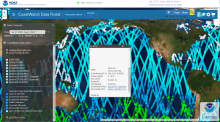NOAA NCEI Blended Seawinds (NBS v2)
The NOAA NCEI Blended Seawinds (NBS) version 2.0 dataset synthesizes observations from multiple satellites (up to seven satellites since June 2002) to create gridded wind speeds (10m, neutral). This is an updated version of the existing NOAA NBS v1.0, which is a global gridded 0.25° and 6-hourly sea surface winds product that has wide applications in marine transportation, marine ecosystem and fisheries, offshore winds, weather and ocean forecasts, and other areas.








